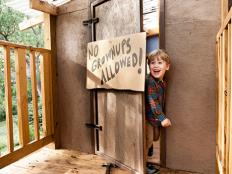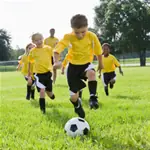
Whether you're working to support your elementary learner complete their sent-home packets right now, watching your middle or high school student navigate their school's new online learning platform and routine or managing more at-home time with your young ones who can no longer go to daycare for the few hours a day you had some time to yourself, helping to cultivate a positive attitude toward learning in your home environment will not only make this transition more manageable but create lifelong positive impacts for our kids as well.
Embrace Mistakes
No matter if they're learning to ride a bike, throw a baseball, read or grasp that new math concept, learning to do something new is going to come with the same blubbery, wobbly possibility for blunders and "almost there's" that come with first words and first steps. Likening these new learning opportunities to these celebrated "firsts" is a helpful comparison to encouraging your child to view mistakes as a natural, healthy (and even helpful!) part of the learning process.
As our kids get older and their learning becomes more social (among peers and siblings), the question becomes one of finding ways to help them manage these moments where they might fail without embarrassment or a learned sense hopelessness. How do we help our kids view mistakes in a healthy, productive way?
From formally framing your child's imperfect work/art in your home in thoughtful ways to using stories about working with and learning through mistakes we make when we learn a new skill or concept, there are a number of ways—both subtle and blatant—to emphasize the importance of working through our mistakes and imperfections. Beautiful Oops by Barney Saltzberg, creatively demonstrates embracing artistic errors and can lead to much deeper conversation about the beauty in imperfections and the things we can learn and see through them with older kids.
Ultimately, just as they did after the first fall that followed their first steps, our kids are looking to us as a model and a compass for how to respond. If we light up, they do too, but if we look worried, they cry. Not to mention that the way we respond to mistakes and blunders will most directly affect how our children respond to their own. So, next time you burn the cookies or spill your tea, give yourself some grace before getting too upset. You may be surprised at how fast they mirror the actions right back to you in their own experience!
Make Time to Highlight and Define Success
It's hard to continually embrace mistakes if these mistakes are not separated by moments of success—if we burned the cookies every time we made cookies, eventually we would stop making cookies. We need to give our kids (and ourselves) the opportunity to celebrate the moments when we get it right! Reflecting on what went wrong and how we can learn from it is best fueled by the opposite: reflecting on what went right, where we are strong and where we can go next.
So, if your child is getting frustrated in learning something new, maybe it's time to reevaluate the skill or concept they're working to understand and break it into smaller parts. It seems almost silly to think, but we don't pick up our children from school or practice each day reflecting on why they haven't been promoted to the next grade level or sports division yet. We know these are long-term goals that take time. Instead, we talk about the small steps they're making toward these bigger "promotional" goals: finishing a new book, being able to explain their steps in a math problem, performing a new skill to a group or class, etc. The same can be applied to finishing weekly packets of work, learning to ride a bike and mastering a cartwheel—the more identified steps we have toward accomplishing something new, the more opportunity there is to celebrate!
Take time to help your child identify their own goals and the steps they'll need to meet along the way. Sometimes you can see these steps ahead of time, and a helpful tool for outlining this is a goal ladder. Simply checking off those steps is a moment to celebrate a success! Other times, you really have to look back to see and celebrate growth. The tomato plant in the backyard doesn't look much different today than it did yesterday, but if you compare it to the way it looked weeks ago, you'll notice a great deal of growth! Encourage your child to keep a journal or look back on home videos of sports games as a family to highlight growth.
Use science, imagery and stories to help them connect their life and experience to that around them. Use charts, video, pictures and images to help them see and celebrate their progress and growth (especially toward those long-term, challenging goals). And help them see that their success should be no different than just that—their own. Celebrate their uniqueness by celebrating with each person the moment they achieve their mark with the same gusto as the rest.
Encourage Questions and Play
Mistakes and successes aside—learning is really only going to happen when there is a need, want or general interest in the topic, concept, skill or process. Sure, we can work hard to create scenarios for learning (that is what schools work very hard to do), but the more we can do early to help our children stay curious, the more likely they are to seek out new knowledge and skills as they get older. Staying engaged in their learning process creates "lifelong learners."
Our littlest ones are naturally curious; let them ask "why". Once they've learned that asking questions will often spark a conversation, it can be relentless! However, the more thoughtfully we can reply to their inquiries, the more sophisticated their questions and conversations will be in time. Teach them about the other question words like what, when and how—and ask them questions of your own to encourage them to not only explain, but see what other questions they have as well. Help them stay curious!
When our kids are in their earliest developmental stages, their imaginative play time is their learning time. As tasks get more complicated and school becomes an increasingly bigger part of their life, play naturally becomes a lesser part of their day. However, a trivia game is always more fun than rereading notes alone, and practicing long division with chalk on the driveway is abundantly more beautiful (and perhaps engaging) than a worksheet. Keeping this in mind might help pull your child out of a learning rut—whether they're in fourth grade or high school.
We are never too old to play, and there's always something to be learned in games and fun. We can leverage this as parents, coaches and teachers to help our kids reach new heights in their academic and athletic achievements, but we can also just remember that a family game is a good way to engage in the highs and lows of learning and working together to support each other as we grow!
READ THIS NEXT: 10 Ways to Make Homework Fun









Discuss This Article